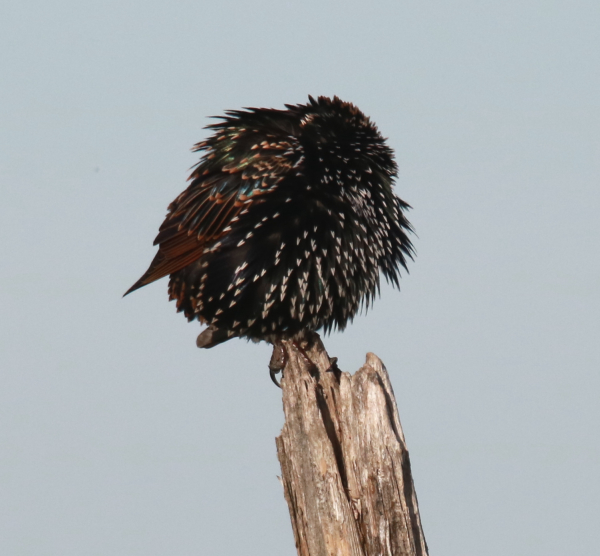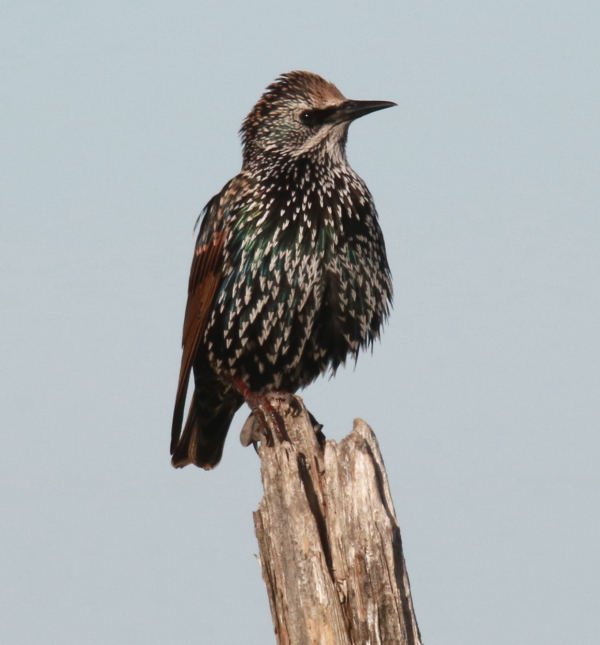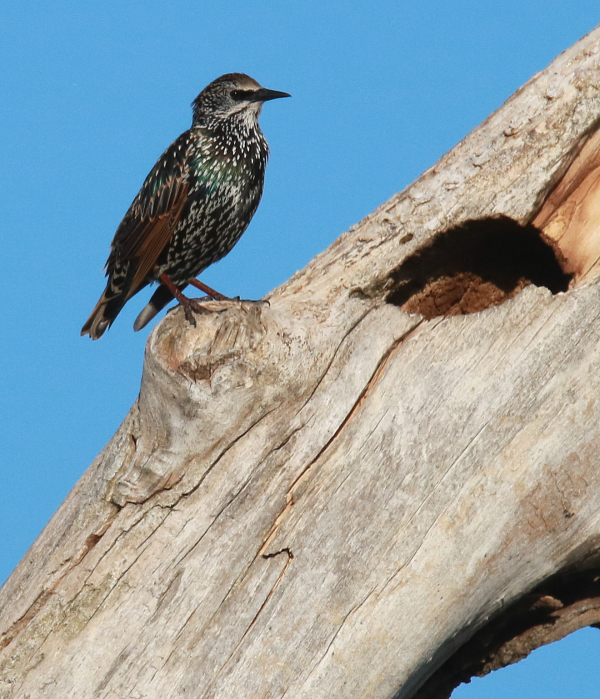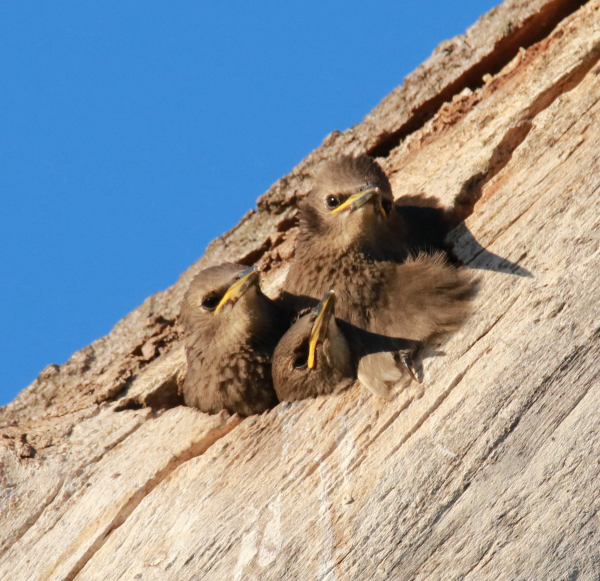
A literal ball of feathers, what prize could be balancing at the top of this branch on the lone prairie?
Saturday, the timing was right, the light was right; a bird was perched on a weathered wood branch, but what’s that?! At first it looked like a ball, a ball of feathers; but a moment later the preening star showed its full brilliance with diamond white accents on metallic-colored feathers. But what is that? It’s a bright new star – a starling. Not the bird I was expecting, but if it was a meadowlark or a Bobolink I would have taken advantage of this opportunity – and I took the opportunity to photograph this European Starling too.
Often, we overlook starlings; or we try to dismiss them as unworthy birds due to their status as introduced competitors for cavity nesting sites. They will even strong-arm larger birds like Red-headed Woodpeckers away from a newly excavated nest site, not to mention any smaller native cavity nesters like bluebirds, chickadees, and nuthatches. We nature photographers often dismiss or avoid European Starlings as photo subjects, but here I was with a fine opportunity to photograph one in basic plumage under excellent conditions, and I was all about taking advantage of the moment.

A transformational move revealed the bird behind the feathers and provided a classic portrait of a European Starling in basic plumage. This was not an urban starling, but a wild and wooly prairie startling far afield.
I have a few photos of starlings in their most colorful alternate plumage during pre-nesting and nesting periods, but I was actually looking for a chance to photograph a starling in the drabber basic plumage. Drabber? Are those white diamonds shining on its feathers drabber? In retrospect, this photo opportunity was as good as any last week, and the bird was much more trusting than most starlings I encounter in the outback of Dakota. Yes, this was not an urban startling; it was positioned at a very remote location miles from any ranch or farm, and I count the resulting portrait as good as it gets for the species in basic plumage.
Timing my afternoon drive during the current prime lighting period – 4:00pm to 6:30 – it was about 5:00 when I encountered the ball of feathers starling – perfect timing for perfect lighting. I had my camera preset with an aperture of f7 using the Av (Aperture Priority) setting on the Mode Dial. I never use an automatic setting, but the Aperture Priority setting provides a degree of automatic – but with my input: I set the aperture with respect to the shutter speed I need under given conditions. With the bright lighting conditions, the resulting shutter speed was super-fast at 1/2000 of a second by using the f7 aperture.

The perfect 5pm sunlight angle provided exact colors free of shadows as 1 of 3 starlings perched on a tall cottonwood snag next to a previously used nesting cavity.
So why did I choose f7? First, it gives me a fast shutter speed when using the Av setting; but it also provides a narrow area in focus around the bird. With the uniformly colored sky background, the aperture was less important; but if the bird was positioned with the adjacent prairie hillside in the background about 30 yards behind it, the hill would be blurred out of focus, creating a green-yellow background that emphasized the bird and its perch in the resulting photo.
Doubling Back

In early June, Paul photographed the nesting cavity with 3 soon to fledge nestlings waiting for their next meal. Could these nestlings be the same 3 starlings he encountered there last week?
|
After leaving the “drab star,” I continued on something of a circle route that took me back down the starling road about a half-hour later. At that point, 3 starlings were perched on a lone barkless cottonwood snag that had a cavity near what was now the top. Back in June, I photographed 3 nestlings peering out of the same cavity – could these be the same young starlings still attached to this monolithic nest site? Or was the startling three-some at the site by coincidence? Either way, the birds permitted me to photograph them from a distance while the sun still provided ample shadowless illumination, and I zoomed in on the one closest to the cavity entrance to share it with you.
The photo I took back in early June of the soon to fledge nestlings was a matter of lucky timing, finding the young starlings just as they began to poke their heads out of the cavity to meet an adult returning with food in an effort to compete for that next morsel with the other 2 nest mates. As you can see when comparing the 2 overview photos of the nesting cavities, the top end of the snag broke off during a wind storm at some point during the summer, but it looks like the cavity itself survived.

A quick zoom showed a wider overview of the cavity site, the nestlings, and the arriving adult.
|
To top off this article, I wanted to share an image of a European Starling in its full-color alternate plumage as it was perched on a high point on territory where it sang periodically before initiating nesting. For that March photo, I again positioned myself between the sun and the bird during an afternoon photo hike. The darker plumage and iridescent colors of the bird in alternate plumage set it apart as a true beauty of the avian world, or at least our personal corner of it.
These starling photo subjects helped me to appreciate the species more, and they made me understand that photographing birds does bring us closer to that individual, group, or species – and that’s a great insight for birders to understand and embrace. I sure hope you are enjoying this beautiful period of the fall season and all the birds that you encounter along the way!
Article and photographs by Paul Konrad
Share your bird photos and birding experiences at editorstbw2@gmail.com